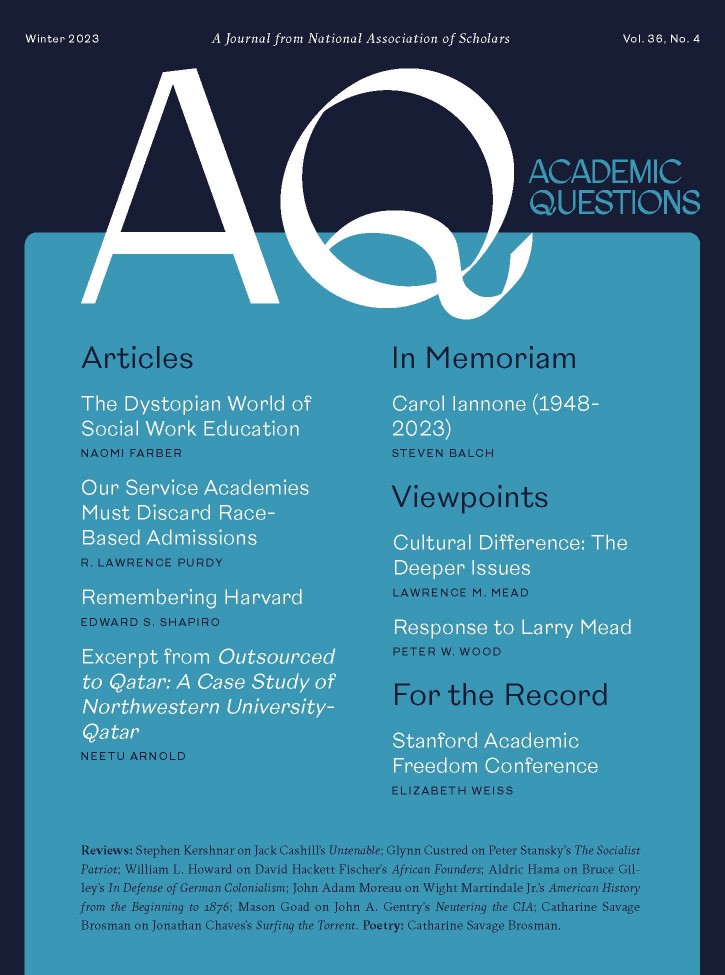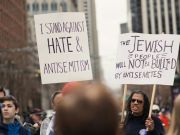Untenable: The True Story of White Ethnic Flight from America’s Cities, Jack Cashill, Post Hill Press, 2023, 288 pp., $28.00 hardcover
In Untenable: The True Story of White Ethnic Flight from America’s Cities, Jack Cashill provides a brilliant and highly readable discussion of white flight from Newark, New Jersey. The book includes funny asides, history, newspaper descriptions, personal stories, and sociological studies. Two features make the book compelling: Cashill’s personal touch—he includes colorful family stories—and his scathing rejection of conventional academic and politically correct explanations of white flight. In short, the book is a gripping biography of a neighborhood and a city.
Cashill’s description of Newark in its heyday and descent into a decrepit, destructive mess is amazing. The book begins with Cashill’s personal story interspersed with the history of his neighborhood, Roseville. Cashill’s story of being a boy playing in Pigtails Alley (complete with ethnic jokes, hard-working blue-collar immigrants, Irish-and-German ancestry, large families, and ne’er do family members) and Norman-Rockwell-like urban neighborhoods is memorable. He describes his own neighborhood in striking terms, including stoop ball, trips down to Florida in a rumble seat, unsupervised sledding on Flexible Flyers, Brooklyn Dodgers, and an unsuccessful Davey-Crockett suit. The households, Cashill observes, were real-world versions of the fictional families he used to watch in Leave It to Beaver, The Life of Riley, and The Honeymooners.
Cashill also describes his police-officer father’s suicide. He does not get sidetracked exploring how this affected his brothers and him. I wish he had done so.
Cashill cites letters from contemporaries—now older adults—who affirm his view of the Roseville neighborhood in the 50’s and 60’s in which they grew up. The word “idyllic” and its synonyms show up repeatedly. The neighborhood had beautiful and well-attended churches, butcher shops and deli’s, Halloween parades, large numbers of free-range children, playgrounds galore, soap box derbies, small stores sitting amongst single family homes, spaghetti dinners, St. Patrick’s Day parades, and two movie theaters. All this occurred within the few blocks that constituted the Roseville neighborhood. One letter pithily describes the Roseville neighborhood, “We had it all, the friends, the families, the neighborhood culture, and endless days and nights of sitting on the front porch and sharing time together.”
Cashill warmly describes stoop culture. The neighborhood consisted of remarkably stable families and close-knit neighbors who spent many hours on their front stoops. He points out that in 1950 on his street (Myrtle Avenue), there were eighty-three married couples, seventy-nine of them with an employed male head of household. The couples included husbands with mostly blue-collar jobs, including bartender, butcher, firefighter, janitor, police officer, truck driver, and so on. The few couples without an employed male head of household included two couples who were retired and two couples who were unemployed. Two widows also headed households. In contrast, Cashill observes, many blocks in Newark today cannot boast a single male married head of household.
Cashill’s description of the neighborhood he grew up in focuses on colorful Irish characters, blue collar workers, and intact, large families. His description of his father’s (Bill’s) childhood is interesting and illustrates how childhood poverty did not prevent his father from making good decisions and thriving in Newark, at least for a while. Cashill describes how Bill was on the football team but had to miss every game because he had to work. His father described how they made footballs out of a can and newspapers and kites out of newspaper and basket staves. Bill married Cashill’s mother when the former was nineteen and the latter fifteen. He describes how his mother borrowed a neighbor’s baby to keep her husband from being drafted in World War II.
Cashill’s description of the Jewish and Italian people of Newark is fun, honest, and insightful. He describes the Jews as including some of Newark’s most famous residents, including Fanny Brice, Edward Koch, Jerry Lewis, and Philip Roth. He describes the importance of the Jewish-owned Bamberger’s to the city, an epic department store. In describing the Newark neighborhoods, Cashill cites Roth’s literary persona, Nathan Zuckerman, from Roth’s novel American Pastoral. Cashill also explores Roth’s depiction of a well-intentioned Jewish teacher in an inner-city school when Newark public schools decayed in I Married a Communist. Along the way, Cashill describes the first-rate high school, Weequahic, that gave rise to overperforming Jewish Newark residents.
Cashill describes Italians as masculine and romantic. He describes how they sang at the street corner while at the same time keeping their weightlifting equipment there. He describes how they stood their ground against the incursion of destructive inner-city violence. The Italians, he notes, did not cut and run. He describes his mother’s funny view that Jews make good husbands but bad wives, whereas Italians make good wives, but bad husbands.
Cashill’s description of the downfall of Newark is electric. For example, from 1960 to 1967 in New Jersey, roughly, the number of burglaries and robberies doubled, murders increased by 60 percent, and vehicle thefts tripled. Cashill notes that Newark as well as other troubled cities, such as Camden and Paterson, drove these numbers. He discusses how public housing projects changed from clean, friendly neighborhoods to eyesores that concentrated crime, fatherless households, and poverty. On Cashill’s retelling, fatherlessness caused much of the dysfunction.
The black power movement and the riots in Newark played a central role in the urban decay. The cabbie in the eye of the riot-maelstrom of Newark’s largest conflagration was one of life’s losers. He had a revoked driver’s license, a string of accidents, and was driving the wrong way on a one-way street. When the police pulled him over, he opened the door into the police officer, punched him, and then struggled with the police. On Cashill’s account, quickly thereafter, rumors flared about the police beating the cabbie, professional agitators kicked into action, and aimless, angry young people started looting and rioting. They attacked police officers and firefighters with bricks, rocks, and Molotov cocktails. Buildings burned. Snipers shot and killed a police officer and a firefighter.
The Newark riot, Cashill claims, was one of the worst in American history. Cashill notes that the Kerner Report on the riots said that 44 percent of those arrested had a prior police record and 25 percent were brought up in homes in which no adult male lived. The next year, following the assassination of Martin Luther King in 1968, sixty more buildings burned in two more riots.
Cashill argues that crime, violence, and declining public schools caused white flight. He cites stories of white residents who begrudgingly left their beloved neighborhoods only after being repeatedly victimized. Cashill provides descriptions of people leaving after being burgled, mugged, and having a wife murdered. In short, Newark became untenable. Cashill notes that young Newark whites—having been repeatedly targeted by criminals—were less naïve than their suburban counterparts. The North Ward Italians, he notes, held out longer than did the other white ethnics. Cashill describes how the Italians refused to roll over to urban crime or displacement. In contrast, Cashill notes the Jews—who depended on the excellent public schools—fled after the schools’ quality collapsed.
Cashill is scathing in responding to public intellectuals who cite racism—rather than crime or violence—in explaining white flight. He skewers Ta-Nehisi Coates, Ibram Kendi, and Michelle Obama, and a Princeton professor who specializes in white flight for their accounts. In contrast to their explanations, Cashill argues that urban decay made the flourishing Newark neighborhoods unlivable. The letters he cites capture his explanation.
Leaving Roseville was one of the hardest and most emotional parts of my life. I knew that things had changed. But in my heart, Roseville will always be my home. I will always love our house on the corner of No. 9th and 4th Ave.
God, I miss the Roseville Section. Leaving there was the hardest thing I’ve ever done. It just wasn’t safe to live there anymore.
Cashill’s book is outstanding. It is a superb retelling of an idyllic neighborhood whose members fled in response to urban decay and violence. It combines a gripping retelling of the riots, history, personal stories, sociological data, and the replacement of halcyon neighborhoods with public housing projects. The replacement resulted in broken public schools, crime, and riots. Along the way, Cashill combines personal stories of the neighborhood’s descent with discussion of intellectual studies—for example, Census data, the Moynihan Report and Kerner Reports—and with historical context, specifically the 50’s and 60’s cultural, economic, and political movements.
There were some issues I would have wanted to explore. Cashill’s discussion of the chaos and degradation of the public schools and life in the decaying public housing—with a glaring absence of fathers—is thinly sketched. The retelling is instead from the perspective of Cashill’s friends and neighbors. The perspective of the North Ward Italians seems important but was largely unexplored. Still, no book can do everything and Cashill’s book is badly needed, powerful, and highly readable. The events, people, and stories are memorable.
We should draw a few lessons from this book. First, we should be skeptical of the claim that racism drove white flight. Cashill’s data and stories align to suggest that the concern for crime, decaying schools, and riots played a significant role. Cashill’s explanation for why inner-city dysfunction occurred—fatherless households incentivized through wealth redistribution—is plausible but Cashill does not defend it. There are other explanations—for example, the loss of industry and dysfunctional government—that compete against the fatherless-household explanation.
Second, we should demand that those pushing the racism-explains-white-flight thesis—for example, Ta-Nehisi Coates, Ibram Kendi, and Michelle Obama—respond to Cashill’s arguments. If they refuse to do so, we should see their theses as at best unsupported. We might also conclude such a failure undercuts their overall racialist narrative.
Third, Cashill implicitly argues that friendships and close-knit relations between neighbors make a neighborhood great. Former Roseville children—now older adults—repeatedly describe their childhoods as idyllic. They cite communal activities, extended families living near each other, free range childhoods, friendly-and-respectful neighbors, intact marriages, large families, and stoop culture. The people describing this neighborhood were originally working-class white ethics—heavily Irish in Cashill’s neighborhood—with few of the advantages of education, job security, or wealth that characterize today’s middle and upper classes. Yet it would not surprise us were we to find that the 1950’s-and-1960’s-Roseville children had a better childhood and the adults a richer life than do their middle- and upper-class descendants today. Perhaps this is a lesson regarding how we should live.
In summary, Cashill’s book is superb. It is funny, moving, nostalgic, and sad. He combines a powerful argument for what caused white flight in Newark and similar blue-collar cities with a description of a great neighborhood in a great city. They were great not merely because of the successful people they produced—and they produced many—but also in terms of how much the people loved their neighborhood.
Stephen Kershnar is a distinguished teaching professor in the philosophy department at the State University of New York at Fredonia and an attorney; [email protected]. He is the author of eleven books, including his latest, Desert Collapses: Why No One Deserves Anything (Taylor and Francis, 2021). Kershnar wrote “British Imperialism, the Better Alternative,” a review of Bruce Gilley’s The Last Imperialist, for our Spring 2022 issue.
Photo by spiritofamerica on Adobe Stock














